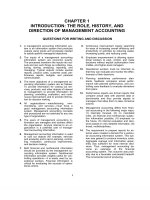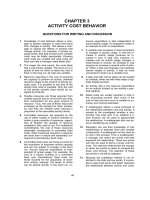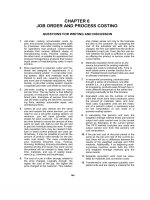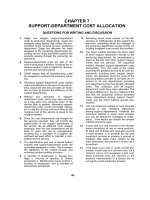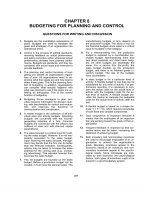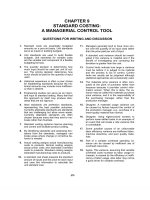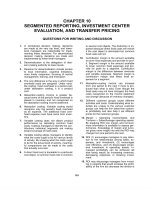Solution manual managerial accounting concept and applications by cabrera chapter 19 answer
Bạn đang xem bản rút gọn của tài liệu. Xem và tải ngay bản đầy đủ của tài liệu tại đây (227.37 KB, 32 trang )
MANAGEMENT ACCOUNTING - Solutions Manual
CHAPTER 19
RELEVANT COSTS FOR DECISION MAKING
I.
Questions
1. Quantitative factors are those which may more easily be reduced in
terms of pesos such as projected costs of materials, labor and overhead.
Qualitative factors are those whose measurement in pesos is difficult
and imprecise; yet a qualitative factor may be easily given more weight
than the measurable cost savings. It can be seen that the accountant’s
role in making decisions deals with the quantitative factors.
2. Relevant costs are expected future costs that will differ between
alternatives. In view of the definition of relevant costs, historical costs
are always irrelevant because they are not future costs. They may be
helpful in predicting relevant costs but they are always irrelevant costs
per se.
3. The differential costs in any given situation is commonly defined as the
change in total cost under each alternative. It is not relevant cost, but it
is the algebraic difference between the relevant costs for the
alternatives under consideration.
4. Analysis:
Future costs:
New Truck
Less: Proceeds from
disposal, net
Replace
P10,200
Rebuild
1,000
P 9,200
Advantage of rebuilding
P8,500
P700
The original cost of the old truck is irrelevant but its disposal value is
relevant. It is recommended that the truck should be rebuilt because it
will involve lesser cash outlay.
5. No. Variable costs are relevant costs only if they differ in total between
the alternatives under consideration.
6. Only those costs that would be avoided as a result of dropping the
product line are relevant in the decision. Costs that will not differ
19-1
Chapter 19 Relevant Costs for Decision Making
regardless of whether the product line is retained or discontinued are
irrelevant.
7. Not necessarily. An apparent loss may be the result of allocated
common costs or of sunk costs that cannot be avoided if the product
line is dropped. A product line should be discontinued only if the
contribution margin that will be lost as a result of dropping the line is
less than the fixed costs that would be avoided. Even in that situation
the product line may be retained if its presence promotes the sale of
other products.
8. Allocations of common fixed costs can make a product line (or other
segment) appear to be unprofitable, whereas in fact it may be
profitable.
9. In cost-plus pricing, prices are set by applying a markup percentage to
a product’s cost.
10. The price elasticity of demand measures the degree to which a change
in price affects unit sales. The unit sales of a product with inelastic
demand are relatively insensitive to the price charged for the product.
In contrast, the unit sales of a product with elastic demand are sensitive
to the price charged for the product.
11. The profit-maximizing price should depend only on the variable
(marginal) cost per unit and on the price elasticity of demand. Fixed
costs do not enter into the pricing decision at all. Fixed costs are
relevant in a decision of whether to offer a product or service, but are
not relevant in deciding what to charge for the product or service.
Because price affects unit sales, total variable costs are affected by the
pricing decision and therefore are relevant.
12. The markup over variable cost depends on the price elasticity of
demand. A product whose demand is elastic should have a lower
markup over cost than a product whose demand is inelastic. If demand
for a product is inelastic, the price can be increased without cutting as
drastically into unit sales.
II. Exercises
Exercise 1 (Identifying Relevant Costs)
19-2
Relevant Costs for Decision Making Chapter 19
Case 1
a.
b.
c.
d.
e.
f.
g.
h.
i.
j.
k.
l.
Item
Relevant
Sales revenue................................. X
Direct materials............................. X
Direct labor.................................... X
Variable manufacturing
overhead........................................ X
Book value – Model E7000
machine..........................................
Disposal value – Model
E7000 machine...............................
Depreciation – Model E7000
machine..........................................
Market value – Model F5000
machine (cost)................................ X
Fixed manufacturing
overhead........................................
Variable selling expense................. X
Fixed selling expense..................... X
General administrative
overhead........................................ X
Case 2
Not
Relevant
Relevant
X
Not
Relevant
X
X
X
X
X
X
X
X
X
X
X
X
X
X
X
Exercise 2 (Identification of Relevant Costs)
Requirement 1
Fixed cost per mile (P3,500* ÷ 10,000 miles)..........................................................
P0.35
Variable operating cost per mile................................................................................
0.08
Average cost per mile................................................................................................
P0.43
* Depreciation...............................................................................................................
P2,000
Insurance....................................................................................................................
960
Garage rent.................................................................................................................
480
Automobile tax and license.......................................................................................
60
Total............................................................................................................................
P3,500
Requirement 2
The variable operating costs would be relevant in this situation. The
depreciation would not be relevant since it relates to a sunk cost. However,
any decrease in the resale value of the car due to its use would be relevant.
The automobile tax and license costs would be incurred whether Ingrid
decides to drive her own car or rent a car for the trip during summer break
19-3
Chapter 19 Relevant Costs for Decision Making
and are therefore irrelevant. It is unlikely that her insurance costs would
increase as a result of the trip, so they are irrelevant as well. The garage
rent is relevant only if she could avoid paying part of it if she drives her
own car.
Requirement 3
When figuring the incremental cost of the more expensive car, the relevant
costs would be the purchase price of the new car (net of the resale value of
the old car) and the increases in the fixed costs of insurance and automobile
tax and license. The original purchase price of the old car is a sunk cost
and is therefore irrelevant. The variable operating costs would be the same
and therefore are irrelevant. (Students are inclined to think that variable
costs are always relevant and fixed costs are always irrelevant in decisions.
This requirement helps to dispel that notion.)
Exercise 3 (Make or Buy a Component)
Requirement 1
Cost of purchasing
Direct materials
Direct labor
Variable manufacturing overhead
Fixed manufacturing overhead, traceable 1
Per Unit
Differential
Costs
15,000 units
Make
Buy
Make
Buy
P200
P3,000,000
P 60
P 900,000
80
1,200,000
10
150,000
20
Fixed manufacturing overhead, common
Total costs
Difference in favor of continuing to make
the parts
1
0
P170
P30
300,000
0
0
0
P200 P2,550,000 P3,000,000
P450,000
Only the supervisory salaries can be avoided if the parts are purchased. The
remaining book value of the special equipment is a sunk cost; hence, the P3 per
unit depreciation expense is not relevant to this decision. Based on these data, the
company should reject the offer and should continue to produce the parts
internally.
Requirement 2
19-4
Relevant Costs for Decision Making Chapter 19
Make
Buy
Cost of purchasing (part 1)..............................................................................................
P3,000,000
Cost of making (part 1)....................................................................................................
P2,550,000
Opportunity cost—segment margin forgone on a
potential new product line...........................................................................................
650,000
Total cost..........................................................................................................................
P3,200,000 P3,000,000
Difference in favor of purchasing from the outside
supplier.........................................................................................................................
P200,000
Thus, the company should accept the offer and purchase the parts from the outside
supplier.
Exercise 4 (Evaluating Special Order)
Only the incremental costs and benefits are relevant. In particular, only the
variable manufacturing overhead and the cost of the special tool are
relevant overhead costs in this situation. The other manufacturing overhead
costs are fixed and are not affected by the decision.
Per
Unit
P3,499.50
Total
10 bracelets
P34,995.00
Incremental revenue
Incremental costs:
Variable costs:
Direct materials
1,430.00
14,300.00
Direct labor
860.00
8,600.00
Variable manufacturing overhead
70.00
700.00
Special filigree
60.00
600.00
Total variable cost
P2,420.00
24,200.00
Fixed costs:
Purchase of special tool
4,650.00
Total incremental cost
28.850.00
Incremental net operating income
P 6.145.00
Even though the price for the special order is below the company’s regular
price for such an item, the special order would add to the company’s net
operating income and should be accepted. This conclusion would not
necessarily follow if the special order affected the regular selling price of
bracelets or if it required the use of a constrained resource.
Exercise 5 (Utilization of a Constrained Resource)
Requirement 1
19-5
Chapter 19 Relevant Costs for Decision Making
(1)
(2)
(3)
(4)
X
Y
Z
Contribution margin per unit............................................................................................
P18 P36 P20
Direct labor cost per unit..................................................................................................
P12 P32 P16
Direct labor rate per hour..................................................................................................
8
8
8
Direct labor-hours required per unit (2) ÷ (3)...................................................................
1.5
4.0
2.0
Contribution margin per direct labor-hour (1) ÷ (4).........................................................
P12 P 9 P10
Requirement 2
The company should concentrate its labor time on producing product X:
X
Contribution margin per direct labor-hour
Direct labor-hours available
Total contribution margin
P12
× 3,000
P36,000
Y
P9
× 3,000
P27,000
Z
P10
× 3,000
P30,000
Although product X has the lowest contribution margin per unit and the
second lowest contribution margin ratio, it has the highest contribution
margin per direct labor-hour. Since labor time seems to be the company’s
constraint, this measure should guide management in its production
decisions.
Requirement 3
The amount Jaycee Company should be willing to pay in overtime wages
for additional direct labor time depends on how the time would be used. If
there are unfilled orders for all of the products, Jaycee would presumably
use the additional time to make more of product X. Each hour of direct
labor time generates P12 of contribution margin over and above the usual
direct labor cost. Therefore, Jaycee should be willing to pay up to P20 per
hour (the P8 usual wage plus the contribution margin per hour of P12) for
additional labor time, but would of course prefer to pay far less. The upper
limit of P20 per direct labor hour signals to managers how valuable
additional labor hours are to the company.
If all the demand for product X has been satisfied, Jaycee Company would
then use any additional direct labor-hours to manufacture product Z. In that
case, the company should be willing to pay up to P18 per hour (the P8 usual
wage plus the P10 contribution margin per hour for product Z) to
manufacture more product Z.
19-6
Relevant Costs for Decision Making Chapter 19
Likewise, if all the demand for both products X and Z has been satisfied,
additional labor hours would be used to make product Y. In that case, the
company should be willing to pay up to P17 per hour to manufacture more
product Y.
Exercise 6 (Sell or Process Further)
Sales value after further processing
Sales value at split-off point
Incremental revenue
Cost of further processing
Incremental profit (loss)
Product A
P80,000
50,000
30,000
35,000
P(5,000)
Product B
P150,000
90,000
60,000
40,000
20,000
Product C
P75,000
60,000
15,000
12,000
3,000
Products B and C should be processed further, but not Product A.
Exercise 7 (Identification of Relevant Costs)
Requirement 1
The relevant costs of a fishing trip would be:
Fuel and upkeep on boat per trip.............................
Junk food consumed during trip*.............................
Snagged fishing lures...............................................
Total...........................................................................
P25
8
7
P40
* The junk food consumed during the trip may not be completely relevant.
Even if Shin were not going on the trip, he would still have to eat. The
amount by which the cost of the junk food exceeds the cost of the food he
would otherwise consume would be the relevant amount.
The other costs are sunk at the point at which the decision is made to go on
another fishing trip.
Requirement 2
If he fishes for the same amount of time as he did on his last trip, all of his
costs are likely to be about the same as they were on his last trip.
Therefore, it really doesn’t cost him anything to catch the last fish. The
costs are really incurred in order to be able to catch fish and would be the
same whether one, two, three, or a dozen fish were actually caught.
Fishing, not catching fish, costs money. All of the costs are basically fixed
with respect to how many fish are actually caught during any one fishing
19-7
Chapter 19 Relevant Costs for Decision Making
trip, except possibly the cost of snagged lures.
Requirement 3
In a decision of whether to give up fishing altogether, nearly all of the costs
listed by Shin’s wife are relevant. If he did not fish, he would not need to
pay for boat moorage, new fishing gear, a fishing license, fuel and upkeep,
junk food, or snagged lures. In addition, he would be able to sell his boat,
the proceeds of which would be considered relevant in this decision. The
original cost of the boat, which is a sunk cost, would not be relevant.
These three requirements illustrate the slippery nature of costs. A cost that
is relevant in one situation can be irrelevant in the next. None of the costs
are relevant when we compute the cost of catching a particular fish; some
of them are relevant when we compute the cost of a fishing trip; and nearly
all of them are relevant when we consider the cost of not giving up fishing.
What is even more confusing is that CG is correct; the average cost of a
salmon is P167, even though the cost of actually catching any one fish is
essentially zero. It may not make sense from an economic standpoint to
have salmon fishing as a hobby, but as long as Shin is out in the boat
fishing, he might as well catch as many fish as he can.
Exercise 8 (Dropping or Retaining a Segment)
Requirement 1
No, the housekeeping program should not be discontinued. It is actually
generating a positive program segment margin and is, of course, providing
a valuable service to seniors. Computations to support this conclusion
follow:
Contribution margin lost if the housekeeping
program is dropped...............................................................................
P(80,000)
Fixed costs that can be avoided:
Liability insurance................................................................................
P15,000
Program administrator’s salary............................................................
37,000
52,000
Decrease in net operating income for the
organization as a whole........................................................................
P(28,000)
19-8
Relevant Costs for Decision Making Chapter 19
Depreciation on the van is a sunk cost and the van has no salvage value
since it would be donated to another organization. The general
administrative overhead is allocated and none of it would be avoided if the
program were dropped; thus it is not relevant to the decision.
The same result can be obtained with the alternative analysis below:
Current
Total
Revenues...................................................................
P900,000
Variable expenses......................................................
490,000
Contribution margin..................................................
410,000
Fixed expenses:
Depreciation*........................................................
68,000
Liability insurance................................................
42,000
Program administrators’ salaries...........................
115,000
General administrative overhead...........................
180,000
Total fixed expenses..................................................
405,000
Net operating income (loss)......................................
P 5,000
Difference:
Total If
Net Operating
HouseIncome
keeping Is
Increase or
Dropped
(Decrease)
P660,000
P(240,000)
330,000
160,000
330,000
(80,000)
68,000
27,000
78,000
180,000
353,000
P(23,000)
0
15,000
37,000
0
52,000
P (28,000)
*Includes pro-rated loss on disposal of the van if it is donated to a charity.
Requirement 2
To give the administrator of the entire organization a clearer picture of the
financial viability of each of the organization’s programs, the general
administrative overhead should not be allocated. It is a common cost that
should be deducted from the total program segment margin. Fol lowing
the format for a segmented income statement, a
better income statement would be:
Total
Revenues.....................................................
P900,000
Variable expenses........................................
490,000
Contribution margin....................................
410,000
Traceable fixed expenses:
Depreciation............................................
68,000
Liability insurance..................................
42,000
Program administrators’
salaries................................................
115,000
Total traceable fixed expenses.....................
225,000
19-9
Home
Nursing
P260,000
120,000
140,000
Meals on
Wheels
P400,000
210,000
190,000
Housekeeping
P240,000
160,000
80,000
8,000
20,000
40,000
7,000
20,000
15,000
40,000
68,000
38,000
85,000
37,000
72,000
Chapter 19 Relevant Costs for Decision Making
Program segment margins...........................
185,000
General administrative overhead.................
180,000
P 5,000
Net operating income (loss)........................
P 72,000
P105,000
P 8,000
Exercise 9 (Special Order)
Requirement 1
Monthly profits would be increased by P9,000:
Total for
Per Unit 2,000 Units
Incremental revenue..........................................................................
P12.00
P24,000
Incremental costs:
Variable costs:
Direct materials.........................................................................
2.50
5,000
Direct labor................................................................................
3.00
6,000
Variable manufacturing overhead.............................................
0.50
1,000
Variable selling and administrative..........................................
1.50
3,000
Total variable cost.........................................................................
P 7.50
15,000
Fixed costs:
None affected by the special order...........................................
0
Total incremental cost....................................................................... 15,000
Incremental net operating income....................................................P 9,000
Requirement 2
The relevant cost is P1.50 (the variable selling and administrative costs).
All other variable costs are sunk, since the units have already been
produced. The fixed costs would not be relevant, since they would not be
affected by the sale of leftover units.
Exercise 10 (Make or Buy a Component)
The costs that are relevant in a make-or-buy
decision are those costs that can be avoided as
a result of purchasing from the outside. The
analysis for this exercise is:
Per Unit
Differential Costs
Make
Buy
19-10
20,000 Units
Make
Buy
Relevant Costs for Decision Making Chapter 19
Cost of purchasing..................................................... P23.50
Cost of making:
P 4.80
Direct materials.....................................................
Direct labor...........................................................
7.00
Variable manufacturing overhead..........................
3.20
Fixed manufacturing overhead..............................
4.00 *
Total cost...............................................................
P19.00
P23.50
P470,000
P 96,000
140,000
64,000
80,000
P380,000
P470,000
* The remaining P6 of fixed manufacturing overhead cost would not be relevant,
since it will continue regardless of whether the company makes or buys the parts.
The P150,000
rental value of the space being used
to produce part R-3 represents an opportunity
cost of continuing to produce the part internally.
Thus, the completed analysis would be:
Make
Buy
Total cost, as above......................................................................................
P380,000 P470,000
Rental value of the space (opportunity cost)................................................
150,000
Total cost, including opportunity cost..........................................................
P530,000 P470,000
Net advantage in favor of buying.................................................................
P60,000
Profits would increase by P60,000 if the outside supplier’s offer is
accepted.
Exercise 11 (The Economists’ Approach to Pricing)
Requirement (1)
Cecile makes more money selling the ice cream cones at the lower price, as
shown below:
P17.90 Price P13.90 Price
Unit sales.........................................................
860
1,340
Sales................................................................. P15,394.00
Cost of goods sold @ P4.10............................ 3,526.00
Contribution margin........................................ 11,868.00
Fixed expenses................................................
425.00
Net operating income...................................... P11,443.00
Requirement (2)
19-11
P18,626.00
5,494.00
13,132.00
425.00
P12,707.00
Chapter 19 Relevant Costs for Decision Making
The price elasticity of demand is computed as follows:
d
In(1 + % change in quantity sold)
In(1 + % change in price)
=
In(1 +
1,340 – 860
)
860
In(1 +
13.90 – 17.90
)
17.90
=
=
In(1 + 0.55814)
In(1 – 0.22346)
=
In(1.55814)
In(0.77654)
=
0.44349
–0.25291
=
–1.75
Requirement (3)
The profit-maximizing price can be estimated using the following formulas:
Profit-maximizing
markup on variable cost
Profit-maximizing
price
=
–1
1 + d
=
–1
1 + (–1.75)
=
1 +
=
1.333
Profit-maximizing
markup on variable cost
x
Variable cost
per unit
= (1 + 1.3333) x P4.10 = P9.60
This price is much lower than the prices Cecile has been charging in the
past. Rather than immediately dropping the price to P9.60, it would be
prudent to drop the price a bit and see what happens to unit sales and to
profits. The formula assumes that the price elasticity is constant, which
19-12
Relevant Costs for Decision Making Chapter 19
may not be the case.
Exercise 12 (Target Costing)
Sales (50,000 batteries × P65 per battery).....................................P3,250,000
Less desired profit (20% × P2,500,000)........................................ 500,000
Target cost for 50,000 batteries......................................................P2,750,000
Target cost per battery
= (P2,750,000 ÷ 50,000 batteries)
= P55 per battery
Exercise 13 (Pricing a New Product)
The selling price of the new amaretto cappuccino product should at least
cover its variable cost and its opportunity cost. The variable cost of the
new product is P4.60 and its opportunity cost can be computed by
multiplying the opportunity cost of P34 per minute of order filling time by
the amount of time required to fill an order for the new product:
Selling price of
the new product
Variable cost of
the new product
+
Opportunity cost
Amounts of the constrained
per unit of the
resource required by a unit
x
constrained resource
of the new product
Selling price of
the new product
45 seconds
P4.60 + P34 per minute + 60 seconds per minute
Selling price of
the new product
P4.60 + P34 per minute + 0.75 minute
Selling price of
P30.10
the new product P4.60 + P25.50 =
Hence, the selling price of the new product should at least cover both its
variable cost of P4.60 and its opportunity cost of P25.50, for a total of P30.10.
III. Problems
19-13
Chapter 19 Relevant Costs for Decision Making
Problem 1 (Accept or Reject an Order)
Selling price per unit
Less Variable costs/unit:
Materials
Labor
Factory overhead (25%)
Contribution margin/unit
Multiplied by number of units to be sold
Total contribution margin
Product A
P1.20
Product B
P1.40
0.50
0.20
0.10
0.80
P0.40
21,000 units
P8,400
0.70
0.24
0.14
1.08
P0.32
30,000 units
P9,600
Product B should be accepted because its total contribution margin is
higher than that of Product A.
Problem 2 (Eliminate or Retain a Product Line)
Requirement 1
No, production and sale of the round trampolines should not be
discontinued. Computations to support this answer follow:
Contribution margin lost if the round trampolines
are discontinued.............................................
Less fixed costs that can be avoided:
Advertising – traceable..................................
Line supervisors’ salaries..............................
Decrease in net operating income for the
company as a whole.......................................
P(80,000)
P41,000
6,000
47,000
P(33,000)
The depreciation of the special equipment represents a sunk cost, and
therefore it is not relevant to the decision. The general factory overhead is
allocated and will presumably continue regardless of whether or not the
round trampolines are discontinued; thus, it is not relevant.
Requirement 2
19-14
Relevant Costs for Decision Making Chapter 19
If management wants a clear picture of the profitability of the segments,
the general factory overhead should not be allocated. It is a common cost
and therefore should be deducted from the total product-line segment
margin. A more useful income statement format would be as follows:
Trampoline
Round
Rectangular
P140,000
P500,000
60,000
200,000
80,000
300,000
Total
Sales.................................... P1,000,000
Less variable expenses........
410,000
Contribution margin............
590,000
Less fixed expenses:
Advertising – traceable....
216,000
Depreciation of special
equipment.....................
95,000
Line supervisors’
salaries..........................
19,000
Total traceable fixed
expenses...........................
330,000
Product-line segment
margin..............................
260,000
Less common fixed
expenses...........................
200,000
Net operating income
(loss)................................ P 60,000
Octagonal
P360,000
150,000
210,000
41,000
110,000
65,000
20,000
40,000
35,000
6,000
7,000
6,000
67,000
157,000
106,000
P 13,000
P143,000
P104,000
Problem 3 (Product Mix)
Requirement 1
A
P30
25
P5
Selling price per unit
Variable cost per unit
Contribution margin / unit
Divided by no. of hours required
for each unit
Contribution per hour
Product ranking:
1. D
2. B
Product Line
B
C
P25
P10
10
5
P15
P 5
5 hrs.
P1
3. C
10 hrs.
P1.5
4 hrs.
P1.25
D
P8
4
P4
1 hr.
P4
4. A
Based on the above analysis, first priority should be given to Product D.
The company should use 4,000 out of the available 96,000 hrs. to produce
4,000 units of product D. The remaining 92,000 hrs. should be used to
19-15
Chapter 19 Relevant Costs for Decision Making
produce 9,200 units of Product B. Hence, the best product combination is
4,000 units of Product D and 9,200 units of Product B.
Requirement 2
If there were no market limitations on any of the products, the company
should use all the available 96,000 hours in producing 96,000 units of
product D only.
The difference in profit between the two alternatives is computed as
follows:
Contribution margin of combination (1)
Product D (4,000 x P 4.00)
Product B (9,200 x P15.00)
Total contribution margin of D and B
Less contribution margin of D only
(96,000 x P4)
Difference, excess over profit in combination (1)
Problem 4 (Accept or Reject a Special Order)
P 16,000
138,000
P154,000
384,000
P230,000
Requirement 1
The company should accept the special order of 4,000 @ P10 each because
this selling price is still higher than the additional variable cost to be
incurred. Whether or not variable marketing expenses will be incurred, the
decision is still to accept the order.
Supporting computations:
(a) Assume no additional variable marketing cost will be incurred.
Selling price per unit
Less variable manufacturing costs:
Direct materials
Direct labor
Variable overhead
Contribution margin/unit
Multiplied by number of units of order
Total increase in profit
P10.00
P5.00
3.00
0.75
8.75
P 1.25
4,000 units
P5,000
(b) Assume additional variable marketing cost will be incurred.
Selling price per unit
Less variable costs (P8.75 + P0.25)
Contribution margin / unit
Multiplied by number of units of order
19-16
P10.00
9.00
P 1.00
4,000 units
Relevant Costs for Decision Making Chapter 19
Total increase in contribution margin
P4,000
Requirement 2
P8.75, the total variable manufacturing cost.
Requirement 3
Direct materials
Direct labor
Variable factory overhead
Total cost of inventory under direct costing
P5.00
3.00
0.75
P8.75
Requirement 4
Present contribution margin
[10,000 units x (P15 - P9)]
Less proposed contribution margin
[(P14 - P9) x 11,000 units]
Decrease in contribution margin
P60,000
55,000
P 5,000
The company should not reduce the selling price from P15 to P14 even if
volume will go up because total contribution margin will decrease.
Problem 5 (CVP Analysis used for Decision Making)
Requirement (a)
Units sold per month
4,000
5,000
6,000
No. of months
6
15
9
30
Probability
20%
50%
30%
100%
Requirement (b)
Sales (4,000 x P40)
Less variable costs
4,000 units
P160,000
19-17
Production
5,000 units
P160,000
6,000 units
P160,000
Chapter 19 Relevant Costs for Decision Making
Production cost @ P25
Purchase cost @ P45
100,000
-
125,000
-
150,000
-
Total
Contribution margin
P100,000
P 60,000
P125,000
P 35,000
P150,000
P 10,000
Sales (5,000 x P40)
Less variable costs
Production cost @ P25
Purchase cost @ P45
P200,000
P200,000
P200,000
100,000
45,000
125,000
-
150,000
-
Total
Contribution margin
P145,000
P 55,000
P125,000
P 75,000
P150,000
P 50,000
Sales (6,000 x P40)
Less variable costs
Production cost @ P25
Purchase cost @ P45
Total
Contribution margin
P240,000
P240,000
P240,000
100,000
90,000
P190,000
P 50,000
125,000
45,000
P170,000
P 70,000
150,000
0
P150,000
P 90,000
Requirement (c)
Sales Order
Contribution Margin
4,000
P35,000
5,000
75,000
6,000
70,000
Average Contribution Margin
Probability
0.20
0.50
0.30
Expected Value
P 7,000
37,500
21,000
P65,500
Problem 6 (Pricing)
Requirement A:
Sales
Less Variable cost
Contribution margin
Less Fixed cost
Net income (loss)
2005
P 100,000
130,000
(P 30,000)
40,000
(P 70,000)
19-18
2006
P 400,000
520,000
(P120,000)
40,000
(P160,000)
Operating
Result at Full
Capacity
P 480,000
624,000
(P144,000)
40,000
(P184,000)
Relevant Costs for Decision Making Chapter 19
The company had been operating at a loss because the product had been
selling with a negative contribution margin. Hence, the more units are
sold, the higher the loss will be.
Requirement B: P60.14
Requirement C: P74.29
Requirement D: P56.58
Problem 7 (Make or Buy)
Cost of Making
Outside purchase
Direct materials
Direct labor
Variable manufacturing overhead
Fixed manufacturing overhead*
Total cost
Cost of Buying
P90,000
P15,000
30,000
10,000
15,000
P70,000
P90,000
* 1/3 x P45,000 = P15,000
Therefore, the annual advantage to make the parts is P20,000.
Problem 8 (Close or Retain a Store)
Requirement 1
The simplest approach to the solution is:
Gross margin lost if the store is closed..........................................
Less costs that can be avoided:
Direct advertising......................................................................
P36,000
Sales salaries..............................................................................
45,000
Delivery salaries........................................................................7,000
Store rent...................................................................................
65,000
Store management salaries (new employee would
not be hired to fill vacant position at another
store)......................................................................................
15,000
General office salaries................................................................8,000
19-19
P(228,000)
Chapter 19 Relevant Costs for Decision Making
Utilities......................................................................................
27,200
Insurance on inventories (2/3 × P9,000).....................................6,000
Employment taxes*...................................................................9,000
Decrease in company net operating income if the
Ortigas Store is closed...............................................................
218,200
P( 9,800)
*Salaries avoided by closing the store:
Sales salaries.....................................................................................................P45,000
Delivery salaries................................................................................................ 7,000
Store management salaries................................................................................15,000
General office salaries....................................................................................... 8,000
Total salaries...................................................................................................... 75,000
Employment tax rate.........................................................................................× 12%
Employment taxes avoided...............................................................................P 9,000
Requirement 2
The Ortigas Store should not be closed. If the store is closed, overall
company net operating income will decrease by P9,800 per quarter.
Requirement 3
The Ortigas Store should be closed if P200,000 of its sales are picked up by
the Makati Store. The net effect of the closure will be an increase in overall
company net operating income by P76,200 per quarter:
Gross margin lost if the Ortigas Store is closed...................................................................
P(228,000)
Gross margin gained at the Makati Store:
P200,000 × 43%...............................................................................................................
86,000
Net loss in gross margin.......................................................................................................
(142,000)
Costs that can be avoided if the Ortigas Store is closed (part 1)..........................................
218,200
Net advantage of closing the Ortigas Store..........................................................................
P 76,200
Problem 9 (Shutting Down or Continuing to Operate a Plant)
Requirement 1
Product KK-8 yields a contribution margin of P14 per gallon (P35 – P21 =
P14). If the plant closes, this contribution margin will be lost on the 22,000
gallons (11,000 gallons per month × 2 = 22,000 gallons) that could have
been sold during the two-month period. However, the company will be able
to avoid certain fixed costs as a result of closing down. The analysis is:
Contribution margin lost by closing the plant for two
months (P14 per gallon × 22,000 gallons)...............................................P(308,000)
19-20
Relevant Costs for Decision Making Chapter 19
Costs avoided by closing the plant for two months:
Fixed manufacturing overhead cost
(P60,000 × 2 months = P120,000).......................................................
P120,000
Fixed selling costs
(P310,000 × 10% × 2 months).............................................................
62,000
182,000
Net disadvantage of closing, before start-up costs....................................... (126,000)
Add start-up costs....................................................................................... (14,000)
Disadvantage of closing the plant................................................................P(140,000)
No, the company should not close the plant; it should continue to operate at
the reduced level of 11,000 gallons produced and sold each month. Closing
will result in a P140,000 greater loss over the two-month period than if the
company continues to operate. Additional factors are the potential loss of
goodwill among the customers who need the 11,000 gallons of KK-8 each
month and the adverse effect on employee morale. By closing down, the
needs of customers will not be met (no inventories are on hand), and their
business may be permanently lost to another supplier.
Alternative Solution:
Plant Kept
Open
Plant Closed
Sales (11,000 gallons × P35 per gallon × 2)............................
P 770,000
P
0
Less variable expenses (11,000
gallons × P21 per gallon × 2)..............................................
462,000
0
Contribution margin................................................................
308,000
0
Less fixed costs:
Fixed manufacturing overhead cost
(P230,000 × 2;
P170,000 × 2).................................................................
460,000
340,000
Fixed selling cost (P310,000 × 2; P310,000 ×
90% × 2).........................................................................
620,000
558,000
Total fixed cost........................................................................
1,080,000
898,000
Net operating loss before start-up costs..................................
(772,000)
(898,000)
Start-up costs...........................................................................
(14,000)
Net operating loss....................................................................
P (772,000) P(912,000)
Difference—
Net
Operating
Income
Increase
(Decrease)
P(770,000)
462,000
(308,000)
120,000
62,000
182,000
(126,000)
(14,000)
P(140,000)
Requirement 2
Ignoring the additional factors cited in part (1) above, Kristin Company
should be indifferent between closing down or continuing to operate if the
level of sales drops to 12,000 gallons (6,000 gallons per month) over the
two-month period. The computations are:
19-21
Chapter 19 Relevant Costs for Decision Making
Cost avoided by closing the plant for two months (see above)...........................
P182,000
Less start-up costs...............................................................................................
14,000
Net avoidable costs..............................................................................................
P168,000
Net avoidable costs
Contribution margin per gallon
=
=
P168,000
P14 per gallon
12,000 gallons
Verification:
Operate at
12,000
Close for
Gallons for
Two
Two Months
Months
0
Sales (12,000 gallons × P35 per gallon).............................................
P 420,000 P
Less variable expenses (12,000 gallons × P21 per gallon).................
252,000
0
Contribution margin..........................................................................
168,000
0
Less fixed expenses:
Manufacturing overhead (P230,000 and P170,000 × 2
months).....................................................................................
460,000
340,000
Selling (P310,000 and P279,000 × 2 months)................................
620,000
558,000
Total fixed expenses..........................................................................
1,080,000
898,000
Start-up costs.....................................................................................
0
14,000
Total costs..........................................................................................
1,080,000
912,000
Net operating loss..............................................................................
P (912,000) P(912,000)
Problem 10 (The Economists’ Approach to Pricing)
Requirement (1)
The postal service makes more money selling
the souvenir sheets at the lower price, as shown
below:
Unit sales....................................................
P500 Price
50,000
P600 Price
40,000
Sales............................................................
Cost of goods sold @ P60 per unit...........
Contribution margin...................................
P25,000,000
3,000,000
P22,000,000
P24,000,000
2,400,000
P21,600,000
Requirement (2)
The price elasticity of demand, as defined in the text, is computed as
19-22
Relevant Costs for Decision Making Chapter 19
follows:
d
=
=
=
=
=
=
In(1 + % change in quantity sold)
In(1 + % change in price)
40,000 – 50,000
In(1 +
)
50,000
600.00 – 500.00
In(1 +
)
500.00
In(1 – 0.2000)
In(1 + 0.2000)
In(0.8000)
In(1.2000)
–0.2231
0.1823
–1.2239
Requirement (3)
The profit-maximizing price can be estimated using the following formulas:
Profit-maximizing
markup on variable cost
=
=
Profit-maximizing
price
=
–1
1 + d
–1
=
1 + (–1.2239)
1 +
4.4663
Profit-maximizing
markup on variable cost
x
= (1 + 4.4663) x P60 = P328
This price is much lower than the price the postal service has been charging
in the past. Rather than immediately dropping the price to P328, it would
be prudent for the postal service to drop the price a bit and observe what
happens to unit sales and to profits. The formula assumes that the price
elasticity of demand is constant, which may not be true.
The critical assumption in the calculation of the profit-maximizing price is
that the percentage increase (decrease) in quantity sold is al ways the
19-23
Variable cost
per unit
Chapter 19 Relevant Costs for Decision Making
same for a given percentage decrease (increase)
in price. If this is true, we can estimate the
demand schedule for souvenir sheets as follows:
Price*
P600
P500
P417
P348
P290
P242
P202
P168
P140
P117
Quantity Sold§
40,000
50,000
62,500
78,125
97,656
122,070
152,588
190,735
238,419
298,024
*
The price in each cell in the table is computed by taking 5/6 of the price
just above it in the table. For example, P500 is 5/6 of P600 and P417 is 5/6
of P500.
§
The quantity sold in each cell of the table is computed by multiplying the
quantity sold just above it in the table by 50,000/40,000. For example,
62,500 is computed by multiplying 50,000 by the fraction 50,000/40,000.
The profit at each price in the above demand schedule can be computed as
follows:
Price
(a)
P600
P500
P417
P348
P290
P242
P202
P168
P140
P117
Quantity
Sold (b)
40,000
50,000
62,500
78,125
97,656
122,070
152,588
190,735
238,419
298,024
Sales
(a) × (b)
P24,000,000
P250,00,000
P26,062,500
P27,187,500
P28,320,200
P29,540,900
P30,822,800
P32,043,500
P33,378,700
P34,868,800
19-24
Cost of Sales
P60 × (b)
P2,400,000
P3,000,000
P3,750,000
P4,687,500
P5,859,400
P7,324,200
P9,155,300
P11,444,100
P14,305,100
P17,881,400
Contribution
Margin
P21,600,000
P22,000,000
P22,312,500
P22,500,000
P22,460,800
P22,216,700
P21,667,500
P20,599,400
P19,073,600
P16,987,400
Relevant Costs for Decision Making Chapter 19
The contribution margin is plotted below as a function of the selling price:
23,000,000
Contribution Margin
22,000,000
21,000,000
20,000,000
19,000,000
18,000,000
17,000,000
100.00
200.00
300.00
400.00
500.00
600.00
Selling Price
The plot confirms that the profit-maximizing price is about P328.
Requirement (4)
If the postal service wants to maximize the contribution margin and profit
from sales of souvenir sheets, the new price should be:
Profit-maximizing price = 5.4663 × P70 = P383
Note that a P100 increase in cost has led to a P55 (P383 – P328) increase in
the profit-maximizing price. This is because the profit-maximizing price is
computed by multiplying the variable cost by 5.4663. Since the variable
cost has increased by P100, the profit-maximizing price has increased by
P100 × 5.4663, or P55.
Some people may object to such a large increase in price as “unfair” and
19-25
